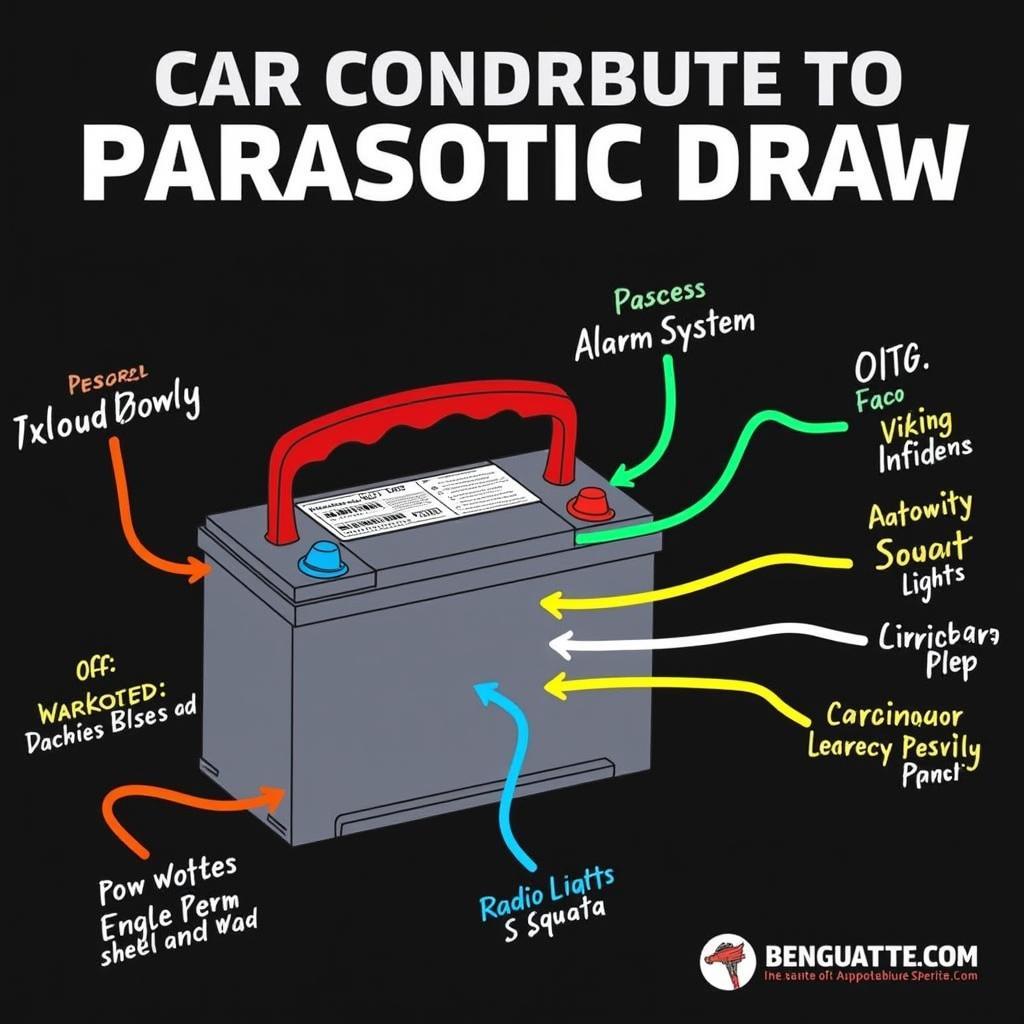A dead car battery is frustrating, especially when it happens unexpectedly. One of the most common culprits is battery parasitic draw, a silent drain on your battery’s power even when the car is off. This article will help you understand what a battery parasitic draw is, how to diagnose it, and what steps you can take to fix it.
What is Battery Parasitic Draw?
Battery parasitic draw, sometimes called parasitic drain, occurs when electrical components in your vehicle continue to consume power even after the ignition is switched off and the key is removed. While some current draw is normal (for things like the clock, alarm system, and computer memory), excessive draw can deplete your battery overnight or over a few days, leaving you stranded.
A small amount of current drain, usually around 50 milliamps or less, is considered acceptable. However, anything significantly higher than that indicates a potential problem and warrants further investigation. Understanding how to identify and address this issue can save you time, money, and the hassle of a dead battery.
 Battery Parasitic Draw Explained
Battery Parasitic Draw Explained
How to Diagnose a Battery Parasitic Draw
Diagnosing a battery parasitic draw involves a systematic approach using a multimeter. Before you start, ensure you have a digital multimeter set to measure DC current (amps).
- Prepare your vehicle: Park your vehicle on a level surface and turn off all accessories. Remove the key from the ignition.
- Access the battery: Locate your car’s battery and disconnect the negative terminal.
- Connect the multimeter: Connect the multimeter in series with the negative battery cable and the negative battery terminal. This means connecting the positive lead of the multimeter to the negative battery terminal and the negative lead to the negative battery cable.
- Observe the reading: The multimeter will display the current draw. As mentioned earlier, a reading above 50 milliamps generally indicates a problem.
- Isolate the culprit: If the reading is high, start pulling fuses one by one while observing the multimeter. A significant drop in the reading when a specific fuse is removed indicates the circuit connected to that fuse is the source of the draw. You can then consult your vehicle’s owner’s manual to identify the components on that circuit.
Common Causes of Battery Parasitic Draw
Several components can cause a parasitic draw. Some of the most common include:
- Faulty alternator: A failing alternator can drain the battery even when the engine is off.
- Interior lights: A stuck glove box light, trunk light, or dome light can contribute to a parasitic draw. Similar to my car battery drains overnight, a seemingly small drain from an interior light can completely deplete your battery.
- Faulty relays or modules: Malfunctioning relays or modules, such as those controlling the power windows or door locks, can draw excessive current.
- Aftermarket accessories: Improperly installed aftermarket accessories, such as car stereos or alarms, can be a source of parasitic drain, particularly if the wiring is incorrect. Understanding how to perform a car battery parasitic draw test is crucial in identifying these issues.
- Glove box or trunk light switch: These switches can sometimes malfunction, causing the lights to stay on even when the compartment is closed.
This is similar to parasitic drain on battery probable causes, which outlines various reasons for a battery drain.
Fixing the Parasitic Draw
Once you’ve identified the source of the draw, the next step is to fix it. Depending on your technical skills, you can attempt to fix the issue yourself or take your vehicle to a qualified mechanic. Simple fixes, like replacing a faulty light switch or fuse, can be done at home. However, more complex issues, like repairing a failing alternator or a malfunctioning electronic module, are best left to professionals. In some cases, understanding the intricacies of parasitic draw test dual battery systems might be necessary.
“Ignoring a parasitic draw can lead to more than just a dead battery,” says John Smith, ASE Certified Master Technician. “Over time, it can damage the battery, shortening its lifespan and potentially leading to costly replacements.”
Preventing Battery Parasitic Draw
Preventing battery parasitic draw involves regular maintenance and careful attention to detail. Make sure all accessories are turned off before exiting your vehicle. Double-check that interior lights are not staying on. Have your vehicle’s electrical system inspected periodically by a qualified mechanic to catch potential problems early.
“Regular maintenance is key to preventing parasitic draw and extending the life of your battery,” advises Jane Doe, Automotive Electrical Systems Specialist. “This is akin to understanding the specifics of parasitic amp draw and its implications.”
Conclusion
Battery parasitic draw is a common problem that can lead to a dead battery and other issues. By understanding how to diagnose and fix this issue, you can save yourself time, money, and frustration. Regular maintenance and careful attention to your vehicle’s electrical system can help prevent parasitic draw and keep your battery healthy for years to come. Addressing battery parasitic draw effectively is crucial for ensuring reliable vehicle operation.

